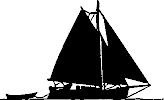
| Tatter Hat A 31' V-Bottom Raised-Deck Cruiser By William Atkin |
| A Cruiser for Pleasure Afloat | |
| During the year 1906 Cottrell Wheeler and I found ourselves in the business of building small custom-built motor boats; "launches" these were likely to be called in those far-away free days. The boat shop was at the creek-side at the head of the harbor at Huntington, N. Y., and a grand place it then was. We had friends, Cottrell and I; among these George A. Fairfield, of Mineola, N. Y., and Roswell Davis of Middletown, Conn. The former M.I.T., 1903 or thereabout, a devil engineer; the latter M.I.T. about a year later, with a degree to practice naval architecture. You might say these two were friends of the shop and that the place had a community of interest for the four of us not ever likely to be repeated this side the rolling Jordan, and certainly not among the ownership and clientele of our modern quantity-production boat shops. I am afraid we were not very efficient -- but we had grand times; the boats came a-pace and we were very happy. | |

| |
We were likely to get very dirty between working on boats, motors, and automobiles; bruises were common and torn garments all part of days work and week ends as well. If there could be yacht clubs, societies and lodges it occurred to us there should be some kind of tiny organization into which the four of us might fit. And so in the twilight one summer's evening we founded the Order of Tatter. Mr. Fairfield became Tatter Finger; Mr. Wheeler, Tatter Shirt; Mr. Davis, Tatter Jama (pajamas); and Mr. Atkin, Tatter Hat. So named, Shipmates, in recognition of various and obvious damages to person and apparel. We left the glitter to the Grand Lodges and the gold braid to the yacht clubs but kept for ourselves the friendship, the truth and the love. Thus it is we have the origin of the name Tatter Hat. The little boat is 31 feet in overall length; 30 feet on the water line; 8 feet 10 inches in breadth; and 2 feet 4 inches in depth below the load water line. The freeboard at the bow is 4 feet 8 inches, and at the stern 3 feet 8 1/2 inches. The deck arrangement is simple. There is a cockpit 12 feet 3 inches long; this has a width of 6 feet 3 inches for its full length. The floor is well above the load water line, 20 inches to be exact, and will of course be self-draining. There is ample headroom below the cockpit deck to clear the top of the motor specified, thus leaving the floor without a step-up or raised motor housing. The side decks have generous width and it seems to me that these wide decks are invaluable lor getting fore and aft and for handling lines, getting aboard from a dock or dinghy. The house sides lead into useful hand rails over the bridge deck. | |

| |
| The cabin is laid out for a party of two, with clothes lockers, separate toilet room, and ample galley. All together there is 6 feet 6 inches of galley room providing a place for two-burner stove, ice box, sink, work table and lockers for dishes, pans, and galley equipment. Water tanks are located beneath the after ends of the berths. The headroom under the cabin top beams is slightly under 5 feet 10 inches and under the companion over 6 feet. | |

| |
The model is of V bottom form with straight sections below the chine lines and moderately moulded sections for the topsides. The moulding in the topsides reaches to the sheer moulding and from this point rises vertically or nearly so to the edge of the raised deck. The line of the sheer moulding is straight; the line of the raised deck hogged. Some one suggested something like that of a PT boat; but it is more like the motor boats designed by the late Mr. John F. Small 25 to 30 years ago and is a very good way in which to provide the greatest headroom in the middle parts of the cruiser, the very place where it is most useful. The keel extends the full length of the hull and has a protecting shoe below the propeller on which to hang the heel of the rudder. An eighth of a mile an hour may be cut from the speed of the little boat because of this arrangement but aside from this the advantage is all on the side of the long keel. The lines were drawn with a view to reach very close to 17 miles an hour if the boat is powered with a motor like the Red Wing six cylinder 58-90 h.p. 320 cubic inch motor. Gray, Kermath, Universal, Scripps, and others produce motors that are well suited as power plants for this particular little cruising boat. A four cylinder 25-45 h.p. Red Wing motor will be enough power for speeds up to 12 miles an hour. I would not advise less or more horsepower than the high and the low mentioned here. | |
| Plans for Tatter Hat are $100 MYSTIC SEAPORT MUSEUM SHIPS PLANS STORE https://store.mysticseaport.org/ships-plans/ shipsplanstore@mysticseaport.org
+1 (860) 572 5360 | |
| BACK TO PLAN LIST | |